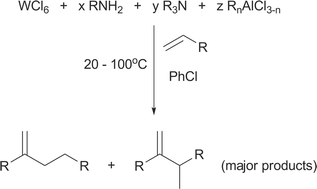Selective dimerisation of α-olefins using tungsten-based initiators†
Abstract
The selective dimerisation of the

* Corresponding authors
a
Sasol Technology UK, St Andrews Laboratory, Purdie Building, North Haugh, St Andrews, Fife, UK
E-mail:
martin.hanton@eu.sasol.com
Fax: +44(0)1334 460 939
Tel: +44 (0)1334 460 830
b School of Chemistry, University of St Andrews, Purdie Building, North Haugh, St Andrews, Fife, UK
c Sasol Technology (Pty) Ltd., Klasie Havenga Street, PO Box 1, Sasolburg, South Africa
The selective dimerisation of the

 Please wait while we load your content...
Something went wrong. Try again?
Please wait while we load your content...
Something went wrong. Try again?
M. J. Hanton, L. Daubney, T. Lebl, S. Polas, D. M. Smith and A. Willemse, Dalton Trans., 2010, 39, 7025 DOI: 10.1039/C0DT00106F
To request permission to reproduce material from this article, please go to the Copyright Clearance Center request page.
If you are an author contributing to an RSC publication, you do not need to request permission provided correct acknowledgement is given.
If you are the author of this article, you do not need to request permission to reproduce figures and diagrams provided correct acknowledgement is given. If you want to reproduce the whole article in a third-party publication (excluding your thesis/dissertation for which permission is not required) please go to the Copyright Clearance Center request page.
Read more about how to correctly acknowledge RSC content.
 Fetching data from CrossRef.
Fetching data from CrossRef.
This may take some time to load.
Loading related content
